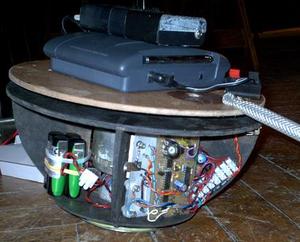[Original at http://www.3via.org/index.php?htm=plesalec/index
also at https://www.turborebop.net/html.php?htm=plesalec/index]
Borut Savski – tretja od treh miniatur iz serije Zvok kot metafora
Borut Savski – third of three miniatures from the series Sound as Metaphore
Dancer / Plesalec
Dancer was presented at Kapelica Gallery/ Ljubljana on 17th of February, after a delay of a week, when an uncontrollable rotation tear out the object’s guts.
One comment though: It came to my mind that the description of the object as “robot” was not originally mine. It was also called “android”, which is little better denotation, since it alludes that a moving object is a metaphore of human. This is the most precise term: a moving object as a metaphore. Why not robot or android? Because these terms define the functionality of machine. I caught myself thinking at one moment that the thing should really see the surroundings and be able to decide intelligently. But this is going too far…
Prezgodnji porod? A prematurely born … was born …
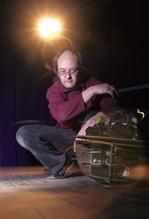
This photo by Miha Fras accompanied the article on the “one of the most poor performances” of machines that ever happened at Kapelica Gallery. Written by Jaša Kramaršič at Mladina. His is also the thesis that “object should be able to speak on it’s own…”
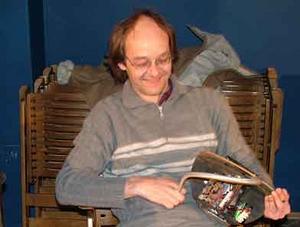 “… nothing is easy” is a citation from a movie by Pedro Almodovar, when Pina Bausch performs one of her very special moves … and it’s coming to my mind often lately …
“… nothing is easy” is a citation from a movie by Pedro Almodovar, when Pina Bausch performs one of her very special moves … and it’s coming to my mind often lately …
Problems? Yes… always…
The robot must be perfectly stable on it’s own (now OK), a better speed control added (OK, done), lowering of the weight (Litium instead of Pb accus – done, YES…). Apart from disbalance control (for changing the direction) also some form of selfbalance control must be added. Disbalancing must have priority over the self-balancing until some moment, then the two must change priorities.
sound excerpts… mp3s:
After the installation a group of four ( Boreut Savski, Matjaž Manček, Luka Prinčič and Petra Tihole) performed an improvisational session, that came out well, so you can listen to it ALL here… (over 50 minutes)
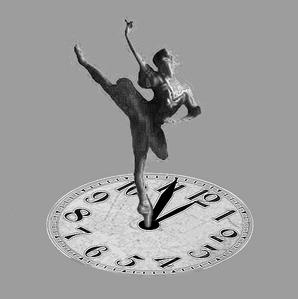
The poetic idea of human self-balancing vith a view of “wholeness” linked with the (human) concept of time which openes the space for many questions of motive and motion …
A dancer – balancing on the tips of her toes. A classical ballet ideal – the art of balancing.
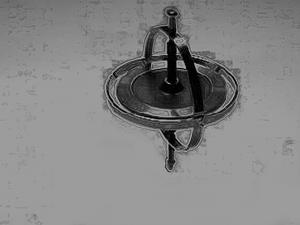
A physical model of dynamically self-balancing system – known as gyro. The spin keeps it balanced and the slope makes it moving … It’s main property is precession – when it turns fast it is able to balance on its pivot. The spinning mass presents an inertia to any turning. This force is called precession.
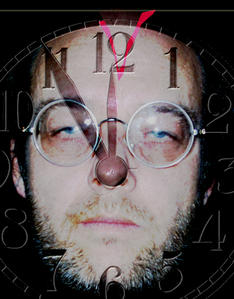
Human psyche is a self-balancing system. The absolute is (always) just around the corner … A clock – a symbol of (linear) time. The subjectivity is a projection forward & backward in time… A clock centered on the nose gives a funny clown-like look. A comment?
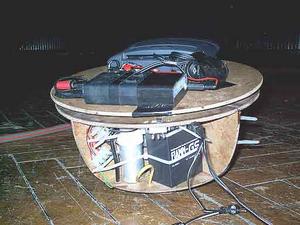
First object (alpha) was unable to spin on its own, because of the weight of lead accumulators. The frame was not very well balanced … a prematurely born …
The second version (beta) is lighter, smaller and stronger but it still has problems on rougher grounds. The neccessary financial injection to upgrade was almost too much …
It is fitted with a tail (as seen on the right). Tail helps to keep the upper part relatively fixed, so that all the spin is transferred to the lower part. It still doesn’t have a sound sensitive counterbalance to change direction (now the tail helps). The batteries and the rough grounds allow for about 15 minutes of “autonomy” …

The next (last?) version will be “production version” with a nickname Rudi (-> Rudolf Nurejev, of course…). I’ll fix some kind of colorful panties for it.
The tail will eventually have to get off, if any kind of “subjectivity” is to emerge (I think). Humans balance themselves with abstract counterweights – not with tail …
DANCER
Dancer is an autonomous moving object that tries to present itself as an artistic subject. It functions on the principle of movement through the sound field in the gallery space. It’s communication channel (-> the higher meaning, sense; -> the motive) is therefore the sound. The sound takes the object here & there accross the space. But the sound as motive is already an abstraction (-> a human translation/ intervention). Primary motive is the motion, the secondary (-> higher) motive is transformed to sound (since we want it to be so…). Somewhere in-between was a moment of estrangement – a change of evaluation system. Since the sound is (nonlineary) linked to movement, this change is not very big, but it should allow the object to achieve the “artistic purpose”.
The process of forgetting the basic reasons opens a space for new understanding. This is how the fragmentation of the (human) world works. New meaning is born out of erasure of old meaning. Objects start to multiply like cells.
This logic is similar to what happens with myths. A myth is an (imaginary) object, that becomes self-contained (and credible; real), when it loses it’s causal connections. We no longer know what are the reasons that “construct” the myth. If we did it would fall apart (lose it’s body) – the word for it is demystification.
The Dancer affects the sound, because it is an active element of the feedback system – it changes it in every moment with its every move. Instant changes are fought back by the various pieces of the coupled system (the object and the space). This is called inertia and is the consequence of the physical properties that cannot change instantly.
Of course, it is again a metaphorical installation. The question now is: is it possible that the subjectivity in human has something to do with the movement (with dynamics, in general) and not (just) the language?
movement -> motive (-> motion)
A female reconvalescent after a serious accident, when she had a total amnesia, told that she had a lot more problem with the learning of walking (balancing), then with the language. The above question is more feasible, if we broaden the physical balancing also to the psychologic balancing, where in everyday life we experience less control.
The split, in psychoanalysis called lack (fr.: manque), prohibits the static stable state (-> everlasting happiness, everlasting misery…). Is it not this split that is a motor (-> a motivator), the generator of changes? In such case also decisions (-> the rationalized changes) become fairly arbitrary (dependent upon the inertia – also & especially the psychologic ones – of each individual system).
About rationalization:
Since with humans it is all about giving sense/ meaning to the past (also to the future) moment, the necessary category to do this is the timeline (linearized time) that opens up the space of cause and effect. It seems to me that this may be the primary human domain.
The question about the Dancer is therefore the realtime dynamic balancing – probably also the falling down. The Dancer balances in the manner of a gyro, to change the direction it uses the change of the vector of object’s weight (gravitation) vector from the balanced (null) position. For the relative stable position of the gravitation vector we use gyroscope – which is the necessary inertial element. The successful act of dynamic balancing is the necessary attribute for an emergence of a musical composition.
Plesalec/ Dancer was produced by Kapelica Gallery with the help of Ministry of Culture of Slovenia and City of Ljubljana.
Plesalec/ Dancer is a part of the Sound as Metaphore series of projects by the same author. Read more about Trivia projects.

